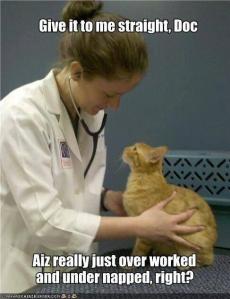I recently reported that the last trip Kirby took to the vet was far more successful than any of the previous. I used to be a nervous wreck taking him in, but I paid attention to my own advice published on an earlier blog. Imagine that! These vets do know what they’re talking about.
The suggestions I followed were to put the carrier in a room and leave it open so Kirby could go in and out without worrying about going out the door and to the car. I also put a towel over the carrier while he was in the car and in the vet’s office. According to the experts, it cuts down on the visual stimulation and keeps them calmer. The third thing I did, which I will mention today, is have them take the top off the carrier and keep him in the bottom while they trimmed his nails, examined him, and gave him his yearly shots. He didn’t make a peep! I was so surprised and elated, I could hardly stand it. I also didn’t go into the examining room on the recommendation of my own vet.
Most cats prefer familiar things and need time to adjust to the unfamiliar. Everything about the veterinary visit is frightening to your kitty, including the carrier, the car and the clinic itself. Starting with the carrier, as I said before, place it in a room where your cat spends a lot of time. Place treats, catnip, or toys in it so your cat will go in, explore, and be able to come back out. You can also spray a synthetic feline facial pheromone in and around the carrier which gives the cat an “everything is good and happy” feeling. When you get to the point that kitty is napping or playing in the carrier, try giving them a treat to get them in the carrier and close the door. Repeat this “game” as often as possible. This makes the routine of getting into the carrier very familiar. When the day of the exam comes, remember to stay calm. Don’t chase your kitty. If you can’t lure them into the carrier with treats, open the top and gently lower them in backwards.
During the car ride, cover the carrier with a towel and place it on the floor of the car for stability. Most prefer quiet, so no loud music.
When you arrive at the clinic, find a secluded spot in the waiting room. Keep the carrier off the floor. (I need to remember this) Many cats are more much comfortable being examined in the bottom of their carrier under their own blanket or towel with the top of the carrier off. Boy, that sure worked with Kirby!
If you have other cats at home, the one returning from the vet won’t smell right to them. If the cats are having a hard time readjusting to each other, use the pheromone spray.
Cats sense our emotions. Staying calm will help your cat from becoming anxious and fearful. Also cats learn positive behaviors from rewards, not punishment or force.
All of the above were suggestions for normal, preventative visits to the vet which we do on a regular basis. However, there are some cat emergencies that need immediate vet attention. They are as follows:
1. Difficulty breathing
Death occurs after three minutes without breathing, so cats with breathing difficulties are on the edge of disaster.
2. Abnormal urination in male cats
This has the potential to be a symptom of one of the most serious crises any cat can face: urinary obstruction. This condition, which is fatal if not treated, occurs when cats are unable to urinate. For anatomical reasons it occurs almost exclusively in males. Females are not likely to die from the problem, but they are likely to be suffering from discomfort that warrants treatment.
3. Signs of severe pain or obvious distress
4. Sudden paralysis of the hind end
Aortic thromboembolism, or ATE, is a complication of heart disease in cats in which a blood clot lodges in the rear (usually) legs. It causes sudden paralysis of the hind end. Affected cats usually will pant, vocalize, and show other signs of distress. It requires immediate veterinary attention.
5. Stopping eating and/or drinking
This often means serious trouble. It is not normal for any individual to go a full day without eating when food is available, and not eating can be a symptom of (kidney failure, complications of diabetes, intestinal obstruction) and a cause of (fatty liver) major health problems.
6. Protracted vomiting and/or diarrhea
This requires immediate veterinary attention, especially when blood is present. Cats who vomit repeatedly or have blowout diarrhea should see the vet immediately.
7. Known ingestion of toxins
Ingestion of toxics such as lily or antifreeze should be treated immediately. Rapid action can dramatically improve outcomes in many different types of toxicities.
8. Profound lethargy or collapse
This should trigger an urgent trip to the vet. Profound lethargy often manifests as “not moving,” hiding in one room for a protracted period, and not reacting to stimuli (such as the can opener or the dog) in a normal fashion.
9. Seizure
Although a solitary seizure is not likely to be life threatening, owners should be aware that seizures often come in clusters that get worse over the course of several hours. They also can be a symptom of exposure to toxins such as mold or low-quality flea control products. Cats who suffer a seizure should go straight to the vet.
10. Major trauma
This should always trigger a veterinary visit. Owners of cats with gaping wounds or massive hemorrhage usually know this intuitively. However, sometimes cats who have fallen from height, been hit by cars, struck by garage doors, or attacked by large dogs can have major internal injuries yet appear unharmed after the incident. Any time you are aware of such an occurrence, your cat should be checked out.
11. Fights with other cats
Cats who have been in fights with other cats should see the vet sooner rather than later. Cat fight wounds are relatively easy to treat with antibiotics if they are caught early. If a delay occurs, an abscess may develop that requires anesthesia and surgery.
The above list is not exhaustive. If you have ANY doubts, get your pet to the vet!
Marion Lovato is the author of Sam, the Superkitty. Her book describes an ordinary cat changing into a superhero to protect his family from things that go bump in the night. Available on Amazon as a paperback or Kindle edition. http://www.amazon.com/gp/product/1604588667





